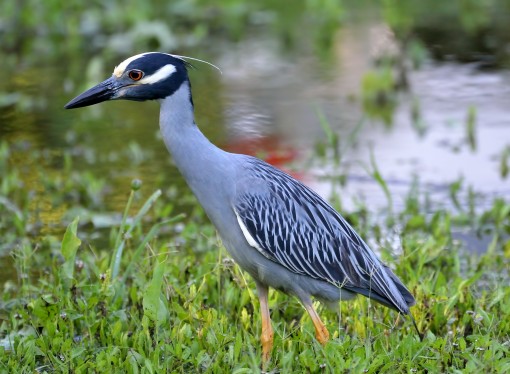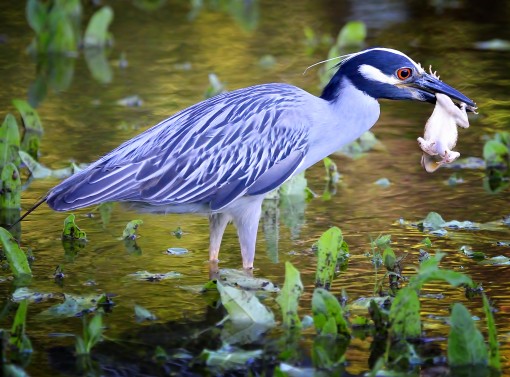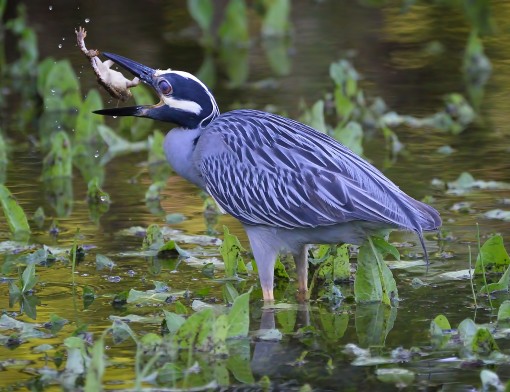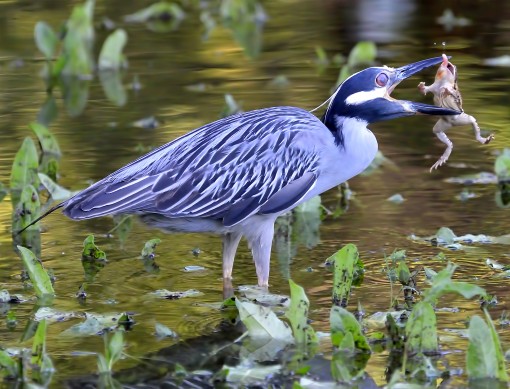The Predator and the Prey
June 3, 2014 | By Shoal Creek Conservancy
This blog post was written by Ted Lee Eubanks. To learn more about the author, please visit this site.

Shoal Creek cuts deeply through white rocks and cedar trees. Without the Colorado River dams and Lady Bird Lake, there would be no pools or puddles. Rainwater speeds into the creek, and even quicker downstream to the river.
One of the few places where rainwater pools is the southeast corner of Duncan Park, directly across West 9th from the BMX course. A small lake had formed there by the end of last week’s rains. Wildlife began to congregate in this pool in short order. Crayfish, toads, frogs, and earthworms crawled, hopped, and swam in the ephemeral puddle. Birds that feed on these creatures were quickly drawn to the pool and to the prey.
Yellow-crowned night-herons are not common along Shoal Creek, although I see a few each year somewhere in the vicinity. Richard King had sent me a photograph of one that he had seen regularly across from the Nokonah the past several weeks. This night-heron, or one like it, relocated to the Duncan Park pool for several days, taking advantage of the abundant prey that swarmed the shallow waters.

I took my telephoto lens and camera over to Duncan after I heard about Richard’s bird. I needed good images of a night-heron feeding. I quickly found the yellow-crowned in question, wading through the rainwater pool in search of prey.
For most of the time the bird fed on earthworms forced to the surface by the rainwater. Scientists speculate that a “shortage of oxygen in the burrows due to heavy rain, formation of carbonic acid, and mating are some of the possible reasons for which earthworms come out from the burrows after rain.” I haven’t a clue, but the night-heron found the earthworms to be easy picking.

Yellow-crowned night-herons are thought to be crustacea specialists; in my experience, they will eat anything that will fit down their throats. As I stood watching the night-heron slurp down one worm after another, it suddenly began sloshing through the water toward the deepest end of the pool. The bird stabbed its bill into the water, and surfaced with a gulf coast toad struggling to escape its grasp.
The night-heron immediately began to masticate the toad from one end to another. As it reached the end, it would toss the toad up in the air, catch the opposite end, and begin chewing the now dead toad for another round. The mastication continued for at least 15 minutes before the night-heron slid the toad down its gullet.
Shoal Creek may not be the Serengeti, but we have enough of our own predator-and-prey dramas to keep me entertained. By detaining more of our stormwater in rain gardens and similar ephemeral pools, we not only rid the water of pollutants and sediments but we create more wetland habitat for yellow-crowned night-herons and gulf coast toads. Join the Shoal Creek Conservancy and help us help them.

